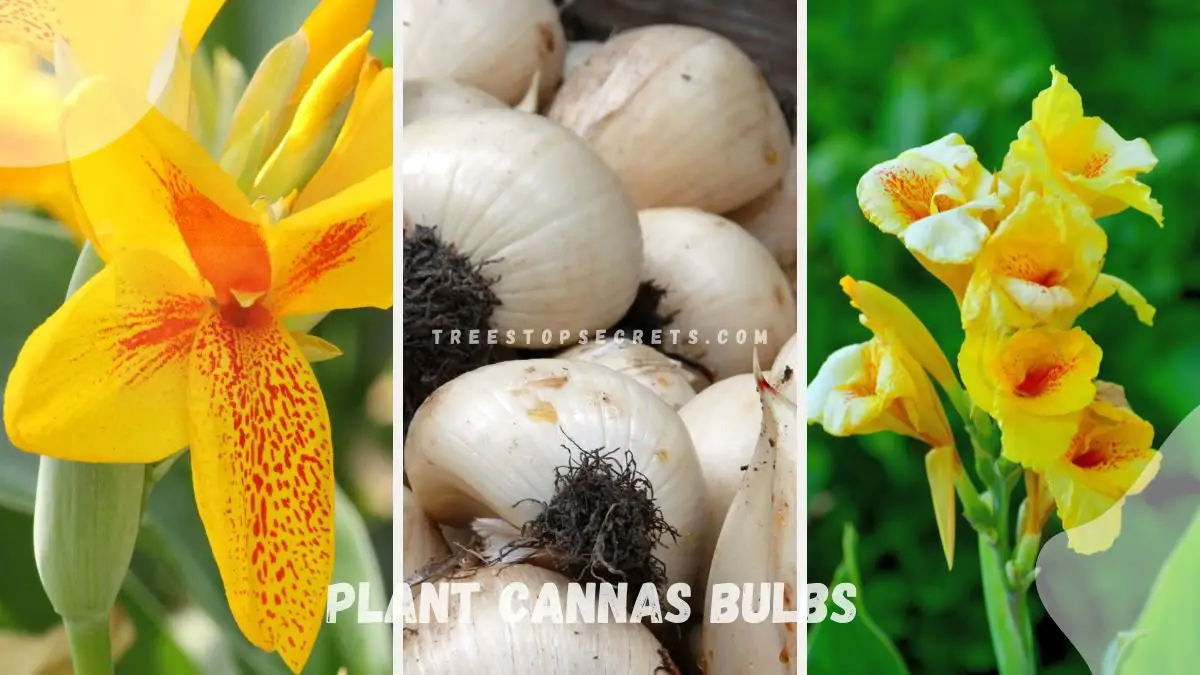If you're wondering how to plant cannas bulbs, rest assured it's simpler than it seems! Cannas are vibrant and hardy perennials that can easily add a tropical feel to your garden. Whether you're a seasoned gardener or a beginner, planting cannas is a straightforward process that yields stunning results. This guide will walk you through everything from choosing the right bulbs to planting and caring for your cannas, ensuring your garden flourishes with these colorful beauties.
To plant cannas bulbs, start by selecting a sunny location with well-drained soil. Dig holes 4-6 inches deep and 12-18 inches apart. Place each bulb horizontally with the eye facing up and cover with soil. Water thoroughly after planting. Cannas thrive in USDA zones 8-11 and prefer consistent moisture. For colder regions, dig up the bulbs before the first frost and store them in a cool, dry place for the winter. Proper spacing and regular watering are crucial for the health and blooming of cannas plants.
For more tips on nurturing your cannas and ensuring they flourish year after year, explore our comprehensive guides. Whether it's choosing the right fertilizers, understanding pest management, or learning how to propagate cannas, we have all the information you need to become an expert in growing these beautiful plants.
Key Takeaways
- Prepare the Planting Area: Ensure the soil is well-drained and choose a sunny location for planting canna bulbs.
- Planting Technique: Plant canna bulbs with the eyes facing up, cover with soil, and water thoroughly after planting.
- Regular Maintenance: Water regularly, provide fertilizer, and deadhead spent flowers to encourage continuous blooming.
- Protect from Frost: Mulch canna plants in colder climates to protect them from frost damage during winter.
- Propagate for More Plants: Divide canna rhizomes every few years to create new plants and maintain their vigor.
- Identify and Address Issues: Monitor for pests, diseases, or nutrient deficiencies and take prompt action to keep your canna plants healthy.
Overview of Cannas
Planting Benefits
- Enhances the garden with a tropical touch.
- Adds height to flower borders.
- Thrives in moist soil and sunny exposure.
Growth Habits
- Exhibits vigorous growth in warm seasons.
- Develops lush foliage and vibrant blooms.
- Grows well in USDA Zones 7–10, showing adaptability.
Preparing to Plant
Best Planting Time
Plant cannas bulbs during late spring or early summer for optimal growth. Starting indoors before the last spring frost ensures successful establishment prior to peak growing season.
Selecting Location
Choose sunny spots for planting cannas bulbs to promote healthy growth. These plants thrive in full sun, making back borders ideal due to their height. While they can tolerate partial shade, full sun encourages the best development.
l Preparation
Prior to planting, amend garden soil with compost or organic matter to enrich its quality. Well-draining soil is essential to prevent waterlogging and promote healthy root development. Rich soil quality plays a crucial role in ensuring robust growth and vibrant blooming of cannas bulbs.
Planting Cannas
Step by Step Guide
Plant cannas by digging holes and placing rhizomes 6 inches deep with eyes facing upward. Space them according to their size variety for optimal growth. After planting, water gently to settle the soil.
- Dig holes and plant rhizomes 6 inches deep with eyes facing up.
- Space rhizomes appropriately based on variety size.
- Water gently after planting to settle the soil.
Watering Needs
Maintain consistent moisture levels in the soil to ensure healthy growth of canna plants. Avoid overwatering as it can lead to root rot, damaging the plant. Adjust the frequency of watering based on the prevailing weather conditions.
- Maintain consistent moisture levels in the soil.
- Avoid overwatering to prevent root rot.
- Adjust watering frequency based on weather conditions.
Care and Maintenance
Light Requirements
Cannas prefer full sun for growth, but can also handle some shade. To thrive, they need 6-8 hours of sunlight daily.
Water and Soil These plants need moist soil to grow well. Ensure the soil drains properly to avoid water buildup. Adjust watering based on weather.
Temperature and Humidity
Cannas flourish in warm temperatures, but frost protection is necessary in cooler areas. Moderate humidity levels are beneficial.
- Requires moist soil conditions for healthy growth.
- Use well-draining soil to prevent water stagnation.
- Adjust watering frequency based on weather conditions.
Fertilizing Tips
For optimal growth, apply balanced fertilizer during the growing season. Avoid too much nitrogen to prevent leaf damage. Feed every 4-6 weeks for continuous blooming.
Advanced Care Techniques
Pruning Practices
Pruning can encourage new blooms by removing spent flowers regularly. Cutting back dead foliage post-growing season helps maintain plant health. Furthermore, pruning damaged or diseased parts is essential for overall plant well-being.
When it comes to pruning practices, it's crucial to remove spent flowers to promote continuous blooming. Cutting back dead foliage after the growing season ensures a tidy appearance and prevents diseases from spreading. Lastly, pruning damaged or diseased parts promptly helps the plant focus its energy on healthy growth.
- Regularly remove spent flowers
- Cut back dead foliage post-growing season
- Promptly prune damaged or diseased parts
Potting and Repotting
Using high-quality potting soil is vital for successful container planting. Repotting every 2-3 years helps refresh soil nutrients and provides ample space for root growth. Ensuring proper drainage in containers is crucial to prevent waterlogging, which can lead to root rot.
Potting and repotting are essential tasks for maintaining healthy cannas bulbs. Using good-quality potting soil ensures proper nutrient supply for optimal growth. Repotting every 2-3 years allows for fresh soil and adequate space for root expansion. Ensuring proper drainage in containers prevents waterlogging, promoting healthy root development.
- Use quality potting soil
- Repot every 2-3 years
- Ensure proper container drainage
Troubleshooting
Pests and Problems
Cannas bulbs are prone to pests such as caterpillars and slugs. These creatures can damage the leaves and flowers, affecting the overall health of the plant. To prevent this, regularly inspect your plants for any signs of infestation. If you notice any pests, consider using natural remedies or pesticides to control them effectively.
Fungal diseases are another common issue that can affect cannas bulbs. One way to prevent these diseases is by avoiding overhead watering. Instead, water the plants at the base to keep the foliage dry. This simple practice can significantly reduce the risk of fungal infections, keeping your cannas healthy and thriving.
When it comes to addressing problems with your cannas bulbs, it is crucial to act promptly. Addressing issues such as pest infestations or diseases as soon as they are noticed can prevent them from spreading and causing extensive damage. Regular monitoring and quick intervention are key to maintaining the health and vitality of your plants.
Overwintering Techniques
During the winter months, it is essential to take proper care of your cannas bulbs to ensure their survival and regrowth in the following season. One effective overwintering technique is to keep potted cannas in cool, dark places where they can remain dormant until spring arrives. This method helps protect the plants from harsh winter conditions while allowing them to rejuvenate when warmer weather returns.
To safeguard your cannas bulbs from frost damage, consider storing their rhizomes in dry, dark areas after the first frost hits. This practice helps prevent freezing and preserves the vitality of the bulbs for the next growing season. By storing them correctly, you can ensure that your cannas will flourish once planted again.
As temperatures drop in preparation for winter, it is crucial to withhold water from your cannas bulbs. This step signals to the plants that dormancy is approaching, prompting them to enter a rest period. By reducing watering gradually as fall progresses, you help your cannas prepare for the colder months ahead, promoting healthier growth when spring arrives.
Propagation
When propagating canna bulbs, the process involves dividing the rhizomes to create new plants. Carefully lift and separate the rhizomes to ensure successful propagation. For a diverse range of canna varieties, consider using seeds as another propagation method.
Dividing canna rhizomes is a common practice among gardeners to spread these vibrant flowers throughout their garden. By gently lifting and separating the rhizomes, you can effectively propagate canna bulbs. This method not only helps in bordering different areas but also promotes healthy growth.
- Propagating through division ensures that each new plant receives sufficient nutrients and space to thrive.
- Using seeds for propagation allows for experimentation with different canna varieties in your garden.
Types of Cannas
Popular Varieties
Canna plants come in various varieties, each offering unique characteristics. For instance, 'Cleopatra' features striking yellow and red blooms, adding a vibrant touch to any garden. On the other hand, 'Pretoria' showcases stunning green and yellow striped leaves, creating a visually appealing landscape. These varieties are popular among gardeners for their distinct colors and patterns, enhancing the overall aesthetic of outdoor spaces.
When selecting canna varieties, consider factors such as height and bloom preferences. Some varieties grow taller than others, making them ideal for creating borders or focal points in gardens. Alternatively, certain varieties produce larger or more abundant blooms, perfect for adding a burst of color to flower beds. By choosing varieties that align with your preferences and gardening goals, you can create a visually pleasing and harmonious outdoor environment.
Key Points:
- Explore different canna varieties like 'Cleopatra' and 'Pretoria.
- Discover unique colors and patterns in canna blooms.
- Choose varieties based on height and bloom preferences.
FAQs
Best Time
Canna bulbs should be planted in fall, at a depth of 4 inches and spaced about 1 to 2 feet apart. Plant them in well-draining soil in sunny areas.
Planting in the fall allows the bulbs to establish roots before winter, ensuring healthy growth come spring. It's essential to avoid planting too early in the fall when temperatures are still warm.
Overwintering
In colder zones, divisions can be overwintered by cutting back the foliage after the first frost. Dig up the bulbs, dry them for a few days, then store them in a cool, dark place.
Overwintering helps protect the bulbs from freezing temperatures that could damage them. By storing them properly, you ensure they remain viable for replanting in the following spring.
Container Growing
Yes, cannas can be successfully grown in containers. Choose a container that is at least 12 inches deep and wide enough to accommodate the size of the plant.
Container growing provides flexibility in ones garden design, allowing for easy movement of the plants as needed. Ensure proper drainage in the containers to prevent waterlogging, which can rot the bulbs.
Closing Thoughts
You've learned all about planting and caring for cannas, from preparation to troubleshooting. Remember the importance of proper soil, sunlight, and watering to ensure your cannas thrive. Don't forget to monitor for pests and diseases regularly to keep your plants healthy. Experiment with advanced care techniques and propagation methods to expand your garden. Understanding the different types of cannas available can add variety and color to your outdoor space.
Now that you're equipped with the knowledge to grow stunning cannas, it's time to get your hands dirty and start planting! Share your newfound expertise with fellow gardening enthusiasts and continue exploring the world of beautiful flora. Happy planting!
Frequently Asked Questions
How deep should I plant canna bulbs?
When planting canna bulbs, ensure they are buried 4-6 inches deep in well-draining soil. Plant them horizontally with the eyes facing up to encourage healthy growth.
What is the best time to plant canna bulbs?
The ideal time to plant canna bulbs is in spring after the last frost has passed. This allows the bulbs to establish themselves before the growing season.
How often should I water my canna plants?
Water your canna plants regularly, ensuring the soil is consistently moist but not waterlogged. During hot weather, increase watering frequency to keep the soil evenly moist.
Do canna plants require full sun?
Yes, canna plants thrive in full sun, receiving at least 6-8 hours of direct sunlight daily. Placing them in a sunny location will promote robust growth and vibrant blooms.
Should I fertilize my canna plants?
Fertilize your canna plants every 4-6 weeks during the growing season with a balanced fertilizer. Avoid over-fertilizing as it can lead to excessive foliage growth at the expense of flowers.
Image Source: Paid image from CANVA




